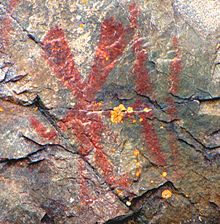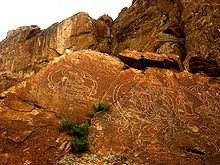
Back Rotskuns AF فن صخري Arabic পাথুরে শিল্পকর্ম Bengali/Bangla Art rupestre Catalan Klippekunst Danish Felsbild German Roka arto EO Pintura rupestre Spanish هنر سنگنگاری FA Kalliotaide Finnish



In archaeology, rock art is human-made markings placed on natural surfaces, typically vertical stone surfaces. A high proportion of surviving historic and prehistoric rock art is found in caves or partly enclosed rock shelters; this type also may be called cave art or parietal art. A global phenomenon, rock art is found in many culturally diverse regions of the world. It has been produced in many contexts throughout human history. In terms of technique, the four main groups are:
- cave paintings,
- petroglyphs, which are carved or scratched into the rock surface,
- sculpted rock reliefs, and
- geoglyphs, which are formed on the ground.
The oldest known rock art dates from the Upper Palaeolithic period, having been found in Europe, Australia, Asia, and Africa. Anthropologists studying these artworks believe that they likely had magico-religious significance.
The archaeological sub-discipline of rock art studies first developed in the late-19th century among Francophone scholars studying the rock art of the Upper Palaeolithic found in the cave systems of parts of Western Europe. Rock art continues to be of importance to indigenous peoples in various parts of the world, who view them as both sacred items and significant components of their cultural heritage.[1] Such archaeological sites may become significant sources of cultural tourism and have been used in popular culture for their aesthetic qualities.[2]

- ^ Cite error: The named reference
Whitley 1was invoked but never defined (see the help page). - ^ Whitley 2005, pp. 1–2.